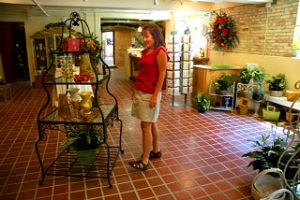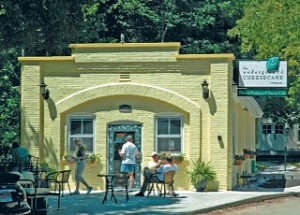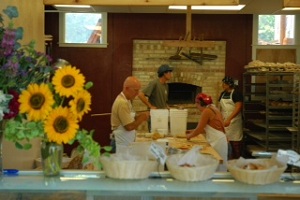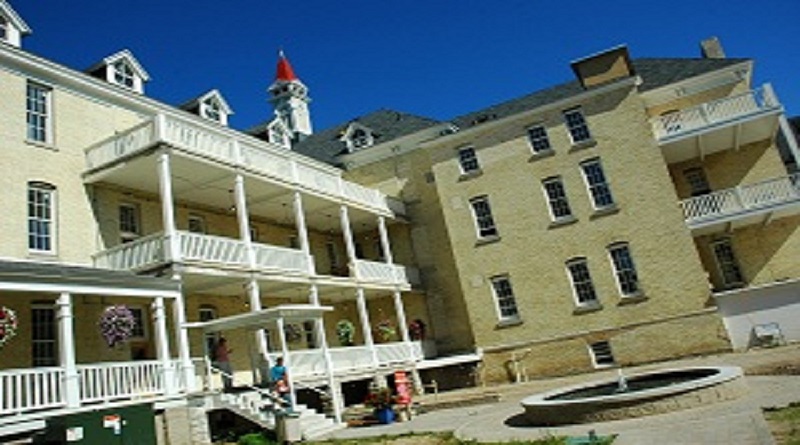Historic Residency at The Village at Grand Traverse Commons
 The Village at Grand Traverse Commons
The Village at Grand Traverse Commons
Traverse City, MI
(231) 941-1900
www.thevillagetc.com
Some might think it’s crazy to take up residency at a former mental institution, but the rooms which once housed patients suffering a multitude of ailments are now being converted into some of the most unique, chic and coveted condos in Traverse City.
The visionary behind The Village at Grand Traverse Commons is Ray Minervini and his dedicated team at The Minervini Group. Renovations first began on the century-old Victorian-Italianate buildings on this 63-acre site in 2002, and since that time the halls and walls that house a rich history of community are being revitalized, one brick at a time.
Touted as one of the largest historic preservation and adaptive reuse development projects in the country – with an expected price tag of more than $200 million – Minervini is dedicated to resurrecting the true sense of community that once thrived at the Traverse City State Hospital (also known as the Northern Michigan Asylum and Traverse City Regional Psychiatric Hospital). The Village project remains a work in progress, with approximately 25 percent of its one million square feet renovated to date, and with another 10 percent scheduled to start this year.
First established in 1885, the Northern Michigan Asylum was one of three complexes in Michigan built according to the Kirkbride Plan (others facilities were located in Kalamazoo and Pontiac). Based on a morally sensitive treatment philosophy, patients were housed in large, imposing buildings with long, rambling wings arranged in a staggered pattern so each patient received ample sunlight and fresh air.
The Northern Michigan Asylum was a prime example of the Kirkbride plan, with its quarter-mile long “Building 50” serving as the focal point of the complex. Dr. James Decker Munson was the first superintendent, from 1885-1924, during which time the institution was expanded to include 12 housing cottages and two infirmaries for the male and female patients who resided there.
A true community existed under Munson’s direction. Patients were invited to work at various jobs around the complex, developing a greater sense of self and purpose and lifting their spirits. Surrounded by magnificent grounds and beautiful gardens, the tranquil park-like setting emphasized the notion that “beauty is therapy.” Patients were encouraged to farm – toiling in the orchards, the vegetable and flower gardens, and tending to the animals such as cows, pigs and chickens. They built furniture, canned fruits and engaged in countless other activities to keep the institution fully self-sufficient.
It is a similar philosophy that exists today at The Village. Residents, business owners, project developers and visitors all contribute to the overall success of the community. With each passing month, there is measured growth in terms of newly renovated spaces, new businesses and new residents. It is Minervini’s passion and dedication to The Village that drives others to be a part of something much bigger.
 Ever since my first tour of The Village in 2005, with Minervini as my guide, I’ve had a desire to be one of the “Village People.” Awed by the stunning architecture, the charming shops and eateries, and the true character of its history, I am drawn each time I visit Traverse City. I aspire to someday call The Village my home.
Ever since my first tour of The Village in 2005, with Minervini as my guide, I’ve had a desire to be one of the “Village People.” Awed by the stunning architecture, the charming shops and eateries, and the true character of its history, I am drawn each time I visit Traverse City. I aspire to someday call The Village my home.
Presently, there are more than 60 condominium units in The Village, ranging from 280-square-foot studios to expansive luxury spaces, gracing as much as 3,500 square feet. Each space boasts dramatic architectural details including 13-foot ceilings, eight-foot windows and brick walls nearly two feet thick. Yet, each unit also has its own character from traditional to modern design elements. The Village renovation property is also northern lower Michigan’s only designated Renaissance Zone, which provides significant tax breaks (virtually no property tax / no state income tax) for buyers.
The one bedroom, one bath, 318-square-foot Mercato Suite 206 is the most affordable unit at $125,000. Although it is compact, there’s no shortage on charm. With the rich feel of a library, this quaint home takes advantage of every nook and cranny, and also affords views of the historic front lawn. On the other end of the spectrum is the Mercato Suite 318, offering three
three bedrooms and two baths in its 2,206-square-foot, two-level unit, with a $685,000 price tag. With its cathedral ceilings, hardwood floors, walk-in closets, fireplace and stunning main-floor archway, this is undoubtedly one of the most impressive units in The Village.
Those looking to settle into one of The Village condos for a vacation stay can also do so. Rates range from $200-$300 per night ($1,200-$1,500 per week), depending on the season, for a 1 bedroom, 1.5 bathroom, 1,150-square-foot suite in Building 50, with many more unit sizes and rental options available.
 Whether staying short or long term at The Village, there’s a true sense of belonging. Walk through the eighth-mile Mercato retail corridor and you’re just steps away from Trattoria Stella, one of Michigan’s premier Italian restaurants. Further down, you will find countless other boutiques, and eateries such as Silvertree Deli, Tastes of Black Star Farms, Sweet Asylum and Cuppa Joe. The brick-lined Mercato walls feature Gallery Fifty’s revolving art exhibitions by local and national artists, and the corridors are inviting gathering places for social mixers, music and game nights, public and private events, and a weekly, year-‘round indoor farmer’s market.
Whether staying short or long term at The Village, there’s a true sense of belonging. Walk through the eighth-mile Mercato retail corridor and you’re just steps away from Trattoria Stella, one of Michigan’s premier Italian restaurants. Further down, you will find countless other boutiques, and eateries such as Silvertree Deli, Tastes of Black Star Farms, Sweet Asylum and Cuppa Joe. The brick-lined Mercato walls feature Gallery Fifty’s revolving art exhibitions by local and national artists, and the corridors are inviting gathering places for social mixers, music and game nights, public and private events, and a weekly, year-‘round indoor farmer’s market.
Visitors and residents at The Village can shop for clothing and accessories, receive massage, spa and beauty treatments; and attend fitness classes without ever leaving the complex. In all, there are more than 70 businesses currently operating within The Village. The former fire station now houses Pleasanton Brick Oven Bakery; the former potato peeling building is The Underground Cheesecake Company; the former laundry facility is space now shared by Left Foot Charley Urban Winery and Higher Grounds Trading Company.
 “The Village is a return to a quality of life that melds old-world, historic charm with cosmopolitan vitality,” says Minervini. “It is a strong, multi-economic and multi-generational community. It is a place of social interaction – a place to live, work and play.”
“The Village is a return to a quality of life that melds old-world, historic charm with cosmopolitan vitality,” says Minervini. “It is a strong, multi-economic and multi-generational community. It is a place of social interaction – a place to live, work and play.”
The grounds of The Village play host to countless world-class festivals, a farmers market, bocce ball tournaments, concerts and artists receptions, and other community events throughout the summer.
Surrounded by an historic arboretum, the grounds are perfect for a relaxing day outdoors. Scenic hiking and biking trails wind along Kid’s Creek and through 320 acres of preserved parkland. Each season, these trails offer a unique experience and showcase the area’s true natural beauty.
“These are the qualities and characteristics that have historically made the most healthy and dynamic neighborhoods with a true sense of place,” Minervini says. It’s this philosophy that continues to draw people to The Village, whether it’s for an afternoon, a weekend or a lifetime.
For more information:
The Village at Grand Traverse Commons
www.thevillagetc.com
(231) 941-1900
Additional reading:
Angels in the Architecture: A Photographic Elegy to an American Asylum
Heidi Johnson and Nancy Tomes
Beauty is Therapy: Memories of the Traverse City State Hospital
Kristen M. Hains and Earle E. Steele
Traverse City State Hospital
Chris Miller
Northern Michigan Asylum: A History of the Traverse City State Hospital
Dr. William A. Decker
Photos courtesy of Traverse City CVB.
Article reprinted (with minor edits) from the Autumn 2010 issue of Michigan HOME & Lifestyle Magazine.

